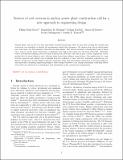Sources of Cost Overrun in Nuclear Power Plant Construction Call for a New Approach to Engineering Design
Author(s)
Eash-Gates, Philip; Klemun, Magdalena M.; Kavlak, Goksin; McNerney, James M; Buongiorno, Jacopo; Trancik, Jessika; ... Show more Show less
DownloadAccepted version (334.4Kb)
Publisher with Creative Commons License
Publisher with Creative Commons License
Creative Commons Attribution
Terms of use
Metadata
Show full item recordAbstract
© 2020 Elsevier Inc. Nuclear plant costs in the US have repeatedly exceeded projections. Here, we use data covering 5 decades and bottom-up cost modeling to identify the mechanisms behind this divergence. We observe that nth-of-a-kind plants have been more, not less, expensive than first-of-a-kind plants. “Soft” factors external to standardized reactor hardware, such as labor supervision, contributed over half of the cost rise from 1976 to 1987. Relatedly, containment building costs more than doubled from 1976 to 2017, due only in part to safety regulations. Labor productivity in recent plants is up to 13 times lower than industry expectations. Our results point to a gap between expected and realized costs stemming from low resilience to time- and site-dependent construction conditions. Prospective models suggest reducing commodity usage and automating construction to increase resilience. More generally, rethinking engineering design to relate design variables to cost change mechanisms could help deliver real-world cost reductions for technologies with demanding construction requirements. Nuclear power plants provide roughly half of the low-carbon electricity in the US. However, projections of nuclear plant costs have repeatedly failed to predict the cost overruns observed since the 1960s. We study the mechanisms that have contributed to the rise in nuclear construction costs over the past 5 decades to understand the divergence between expected and realized costs. We find that nth-of-a-kind plants in the US have been more expensive than first-of-a-kind plants, with “soft” factors external to reactor hardware contributing over half of the cost increase between 1976 and 1987. Costs of the reactor containment building more than doubled, primarily due to declining on-site labor productivity. Productivity in recent US plants is up to 13 times lower than industry expectations. A prospective analysis of the containment building suggests that improved materials and automation could increase the resilience of nuclear construction costs to variable conditions. We study nuclear plant costs in the US over the past 5 decades to understand the mechanisms that contributed to cost escalation and the repeated underestimation of construction cost. We show that declining labor productivity and “soft” costs were leading contributors. Counter to expectation, nth-of-a-kind plants have been more expensive than first-of-a-kind plants. Our prospective analysis of the containment building suggests that the cost resilience of nuclear construction could be increased through improved materials and automation.
Date issued
2020-11Department
Massachusetts Institute of Technology. Institute for Data, Systems, and Society; Massachusetts Institute of Technology. Department of Nuclear Science and EngineeringJournal
Joule
Publisher
Elsevier BV
Citation
East-Gates, Philip et al. "Sources of Cost Overrun in Nuclear Power Plant Construction Call for a New Approach to Engineering Design" Joule 4, 11 (November 2020): 2348-2373. © 2020 Elsevier Inc.
Version: Author's final manuscript
ISSN
2542-4351